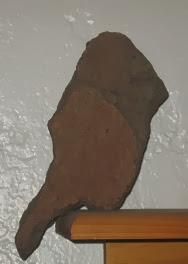Texas incised stone found in an archaeological context by an amateur archaeologist
This find in Texas was interpreted as a tool but may be an example of straight edge use in a European Paleolithic marking tradition as seen in Germany and described by John Feliks in his paper "
The Graphics of Bilzingsleben." Lower Paleolithic art and language traditions may have persisted for tens of thousands of years or people in North America could have independently developed their own marking schemes.
Texas incised stone
"In, On and Infinity," a geometric interpretation of convergent and divergent incised lines by Ken Johnston
Having read some of John Feliks' work about Paleolithic engraved stones, I looked at this stone and could see the first line converging with the second, the second converging with the third farther out and the third line not converging with the fourth with the fourth line angled away so as not to converge with the other lines. When I made an illustration to see what this looked like if I continued the lines, it seemed quite possible this rock was a kind of exogram, containing a recording of geometric and possibly symbolically significant ideas.
As illustrated above these concepts could be described as: In (lines converge inside the stone perimeter), On (lines converge near the edge of the stone) and Infinity (lines never converge). These kinds of concepts are introduced in Feliks' work and it seemed I could develop a potential symbolic meaning for this Texas stone based on those concepts. It was quite strange when I saw the stone and it had this meaning, I felt as if I was intuitively reading a complex idea in a language Feliks had enabled me to recognize. Maybe more objects like this will come to light and show this possible 4 line pattern is more than a one-time chance occurrence.
Amateur and professional archaeologists in North America should avail themselves of the information available from other parts of the world and other temporal periods in order to have a broader range of possibilities in interpreting the meaning of incised portable rocks here.



.JPG)

brbisschm.jpg)




















.jpg)






















